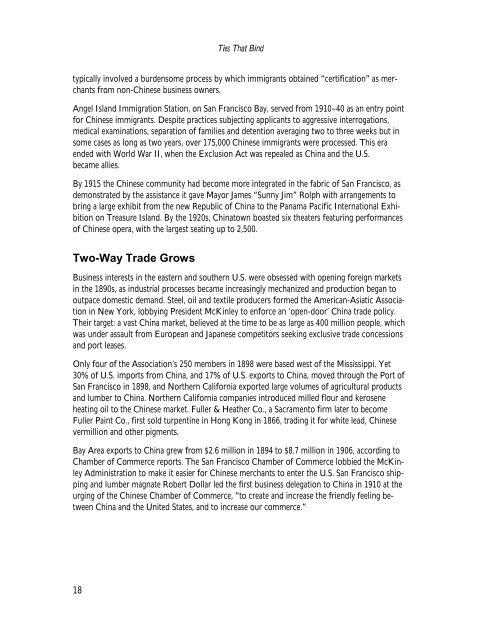Ties That Bind - Bay Area Council Economic Institute
Ties That Bind - Bay Area Council Economic Institute
Ties That Bind - Bay Area Council Economic Institute
Create successful ePaper yourself
Turn your PDF publications into a flip-book with our unique Google optimized e-Paper software.
18<br />
<strong>Ties</strong> <strong>That</strong> <strong>Bind</strong><br />
typically involved a burdensome process by which immigrants obtained “certification” as merchants<br />
from non-Chinese business owners.<br />
Angel Island Immigration Station, on San Francisco <strong>Bay</strong>, served from 1910–40 as an entry point<br />
for Chinese immigrants. Despite practices subjecting applicants to aggressive interrogations,<br />
medical examinations, separation of families and detention averaging two to three weeks but in<br />
some cases as long as two years, over 175,000 Chinese immigrants were processed. This era<br />
ended with World War II, when the Exclusion Act was repealed as China and the U.S.<br />
became allies.<br />
By 1915 the Chinese community had become more integrated in the fabric of San Francisco, as<br />
demonstrated by the assistance it gave Mayor James “Sunny Jim” Rolph with arrangements to<br />
bring a large exhibit from the new Republic of China to the Panama Pacific International Exhibition<br />
on Treasure Island. By the 1920s, Chinatown boasted six theaters featuring performances<br />
of Chinese opera, with the largest seating up to 2,500.<br />
Two-Way Trade Grows<br />
Business interests in the eastern and southern U.S. were obsessed with opening foreign markets<br />
in the 1890s, as industrial processes became increasingly mechanized and production began to<br />
outpace domestic demand. Steel, oil and textile producers formed the American-Asiatic Association<br />
in New York, lobbying President McKinley to enforce an ‘open-door’ China trade policy.<br />
Their target: a vast China market, believed at the time to be as large as 400 million people, which<br />
was under assault from European and Japanese competitors seeking exclusive trade concessions<br />
and port leases.<br />
Only four of the Association’s 250 members in 1898 were based west of the Mississippi. Yet<br />
30% of U.S. imports from China, and 17% of U.S. exports to China, moved through the Port of<br />
San Francisco in 1898, and Northern California exported large volumes of agricultural products<br />
and lumber to China. Northern California companies introduced milled flour and kerosene<br />
heating oil to the Chinese market. Fuller & Heather Co., a Sacramento firm later to become<br />
Fuller Paint Co., first sold turpentine in Hong Kong in 1866, trading it for white lead, Chinese<br />
vermillion and other pigments.<br />
<strong>Bay</strong> <strong>Area</strong> exports to China grew from $2.6 million in 1894 to $8.7 million in 1906, according to<br />
Chamber of Commerce reports. The San Francisco Chamber of Commerce lobbied the McKinley<br />
Administration to make it easier for Chinese merchants to enter the U.S. San Francisco shipping<br />
and lumber magnate Robert Dollar led the first business delegation to China in 1910 at the<br />
urging of the Chinese Chamber of Commerce, “to create and increase the friendly feeling between<br />
China and the United States, and to increase our commerce.”








